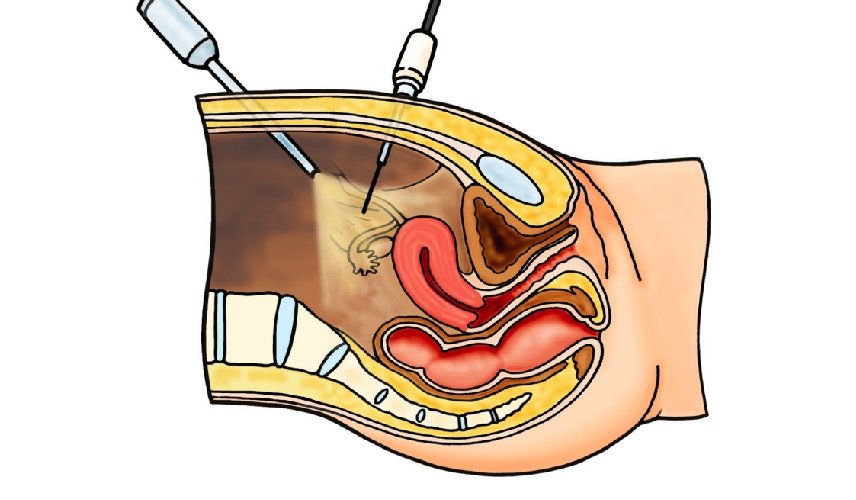What is Laparoscopy Surgery
What is Laparoscopy?
This is a keyhole endoscopy procedure, which allows detailed inspection of female pelvic organs like uterus, cervix, fallopian tubes, and ovaries. Dye is instilled into uterine cavity to see spillage into pelvic cavity through fallopian tubes. This helps to test the patency of the fallopian tubes.
The advantage of laparoscopy over other methods of tubal potency procedure is that it allows for corrective procedures or treatments at the same time as the diagnostic procedure. A due consent form stating all possibilities is a must prior to any such procedure.
Why is laparoscopy done?
Laparoscopy in infertility patients is often recommended, as it is the most reliable way to check the health of the pelvic organs. It allows the tubes to be checked with the dye to make sure they are open and healthy. Laparoscopy is also done to treat certain conditions such as ovarian cyst, endometriosis, fibroids ,adhesions which can be the cause of infertility.
Any surgical procedure has risk but these are relatively minor.
-
Bleeding- the risk of bleeding is very low. It is very rare and is 1:1000 cases. If there is any doubt of internal bleeding, the Laparoscopy needs to be extended into larger incision called as Laparotomy .
-
Infection-To minimise the risk of infection, It is very important to keep the wound clean and follow the after care instructions.
-
Damage to nearby structures –Reproductive organs are surrounded by other pelvic organs like bladder, ureter and intestines. These structures are vulnerable to damage especially in difficult cases of laparoscopy. These complications are not common and are around 1 in 2000 cases.
-
Blood clots (deep vein thrombosis) -There is a subgroup of patients who may be at more risk than others of such complication. It mainly happens when a patient is lying or sitting still for a long time post surgery. It is important to get up and move soon after the surgery to keep the blood in your legs and body flowing.
Laparoscopy and treatment of Endometriosis
Endometriosis is a condition that can cause painful periods and infertility. It is caused when small amounts of tissue from the lining of the uterus or womb known as Endometrium start settling down in the pelvic cavity. Endometrium travels backwards through fallopian tubes and usually settles around or in the ovaries. When endometrium start settling down in the ovaries it is known as Endometrioma. Endometrioma can be treated with laparoscopy by using diathermy (electro cautery or heat treatment)
Laparoscopy and Adhesions (Laparoscopic Adhesiolysis)
The common reasons for adhesion formation in the pelvic cavity are pelvic infection, endometriosis, or previous surgeries. Adhesions are sticky spider webs, which can be thin and flimsy or can be tough and thick. They can cause ovaries, uterus, and fallopian tubes to stick to each other, which in turn can interfere with normal physiology of achieving spontaneous pregnancy.
Laparoscopy is helpful in such cases to free pelvic organs of adhesions. There are chances of recurrence of adhesions.
Laparoscopy and Ovarian Cyst (Laparoscopic Cystectomy)
Ovarian cyst seen a pelvic ultrasound is not necessarily an abnormal condition. Ovary has a tendency to make cyst every month under normal conditions. These can be either follicular cysts or corpus luteal cysts. Usually, they regress on their own and require no intervention or treatment. Sometimes, they do not disappear on their own like Endometriotic cysts. In such cases, the cyst needs treatment either in the form of medical or surgical. In case they need surgical treatments, they can be safely removed with Laparoscopy. Aim of these surgeries is to remove only the cyst and preserve the normal ovary as much as possible to preserve the ovarian reserve. In case the ovarian cyst is very big, it is sometimes not possible to preserve the ovary. Please discuss more with Dr. Puneet or one of the members of the team in case you have a problem with ovarian cyst.
Laparoscopy and Tubal Surgery
Fallopian tubes can be damaged or blocked by past infections or endometriosis or previous surgeries on pelvic organs. Laparoscopy can assist in tubal surgery with aim to open the fallopian tubes and improve the chances of spontaneous conception. It is important to understand that surgery may help to open the fallopian tubes but it may not necessarily help in functioning of the tubes. There can be chances of pregnancy getting stuck in the tube (Ectopic pregnancy). Hence, it’s important to understand about increased risk of ectopic pregnancy with future pregnancies with tubal surgeries.
Individualised approach with these surgeries is key for success of surgeries. All patients with tubal problem may not be suitable for such surgery. Please discuss with Dr Puneet to know about tubal surgery further.


